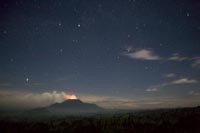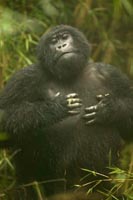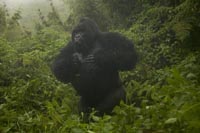 Quite simply, our encounter with Rwanda's
mountain gorillas was probably the most exciting, exhilarating,
and productive wildlife experience we've ever had.
Quite simply, our encounter with Rwanda's
mountain gorillas was probably the most exciting, exhilarating,
and productive wildlife experience we've ever had. Quite simply, our encounter with Rwanda's
mountain gorillas was probably the most exciting, exhilarating,
and productive wildlife experience we've ever had.
Quite simply, our encounter with Rwanda's
mountain gorillas was probably the most exciting, exhilarating,
and productive wildlife experience we've ever had.
And these sentiments were shared by the five photographers who shared this scouting trip with us. It was fantastic.The country came as a complete surprise to us -- mindful of the civil war that took place in 1994 we were, perhaps at least subliminally, expecting to see a worn-torn country with bad roads, terrible accommodations, and unhappy, fearful people. WHAT A SURPRISE!
Rwanda's roads were spectacular -- far, far better than almost any highway in Kenya and equal to Tanzania's -- meaning they were quite good by any standard. The hotel we stayed at in the capital was truly five star, and the food was, for our simple tastes, filling, tasty, and good. That's the creature comforts, which to us is the least important aspect of a trip, but these were met with flying colors. The real surprise, however, was the quality of the photography and the opportunities that were provided. They were nearly boundless.
Mary and I have traveled a lot through Africa and, perhaps because of being continually exposed to scenes, we're rarely moved to attempt to photograph landscape while 'on the road' driving to or from the safari parks in Kenya. One reason for this, I'm sure, is the distances that we travel -- it's just too long a drive to stop for 'tourist' shots. In Rwanda, each day after our gorilla treks we'd travel the countryside and I had to shoot -- the landscapes and the people were absolutely compelling. What a surprise that was.
We spent a total of seven nights in Rwanda, giving us FIVE full days of gorilla trekking. At present there are four habituated groups of gorillas, and four 'research groups' that are presently closed to tourists, and by spending five days we had an opportunity of visiting each group at least once. Each gorilla trek is climaxed by a one-hour session with the gorillas, timed pretty much from the time that you first start taking images. Depending upon the guide you have, that time may tick off for exactly one hour, regardless of the gorillas' accessibility or cooperation, or it may last much longer if the gorillas move off and your guide keeps the clock going by your actual time with the gorillas. We had a guide that went by the quality-contact principle, and I'd say that we had nearly an hour of quality shooting every time we filmed gorillas.




IF YOU THINK ONE HOUR A DAY IS TOO SHORT A TIME FRAME TO MAKE THIS TRIP WORTHWHILE -- YOU ARE VERY WRONG!
The hour limitation is designed to give the gorillas a break from human disturbance. Human activity, especially fast-moving tourists, can disturb the gorillas and make them move off (usually only a few meters before resettling), but our presence also acts as a distraction to the gorillas where they may devote attention to people rather than to their normal routine. Hence the one-hour limit. However, when the shooting is good, the activity and the focus of your attention is so great, that the one-hour limitation seems designed for the people! After an hour, everyone, including indefatigable me, was exhausted, physically and mentally, just from the intensity of the experience. I often found myself thinking "the time must be almost up, it's been so great" only to find that we still had two or three more encounters or shooting sessions with more gorillas.
While our actual gorilla encounter was approximately an hour, our days were activity filled. Breakfast was generally at 6:30AM, and we'd leave for Park Headquarters around 7AM, arriving around 7:15. By 7:45AM we'd be on the road, driving to the parking spot where we'd meet our porters and where we'd begin our hike up to the gorillas. Most days we were down by noon, and the latest was 1:30PM, although we were lucky as some groups as some times of the year might require almost a full day of trekking.
After lunch we'd drive somewhere -- to some hidden mountain lakes, to the Congo border, to a lowland forest, where we'd photograph landscapes and people and generally enjoy the wonderful countryside. We'd return to our lodge around dusk, although on the day we visited the Congo we had a late start and, staying late to photograph the volcano on a time exposure, we arrived back around 8:30PM. On our official tour we'll keep up the same type of schedule, and participants will have the option of accompanying us on these great outings or staying behind and resting. We were tired at the end of the week, from hiking and from the schedule, but we were very glad that we did not take an afternoon off to rest (many groups do nothing but trek in the morning and relax in the afternoon). That choice will be up to the people -- we won't be resting, there's too much to see and do.






Gorilla troop numbers varied from a high of 35 animals to a group of only ten. Our favorite encounter did occur with the group of 35, as it seemed that there were gorillas everywhere and we had some of our most exciting experiences with this troop. At one point it rained heavily and all of the primates (that's human and gorilla) retreated under the tree canopy. There we were, huddled on opposite sides of the trail, the gorillas weathering out the rain or grooming, the people snapping away. As the rain let up the huge (and we are talking HUGE) silverback got up and sauntered down the trail toward us and our guide gently urged us to clear a path and make way. He did not have to ask twice!
Mary and I carried Sigma 120-300mm f2.8 lenses for our principle shooting, and both of us had a 28-135 zoom as a backup for habitat shots and close up encounters. The Sigma was the lens of choice -- ideally groups are supposed to be about 7 meters from the gorillas, although that distance varies as the gorillas move about, but with 120 for the short end we could usually get full-body shots or animals in habitat, and the 300mm was perfect for coming in close and for portraits. One of our party had a 100-400 IS, but at f5.6 the lens was too slow for the usual light so he borrowed my 70-200 2.8 and used that for the shoot. While using a tripod was awkward at times -- the vegetation was thick and moving through bamboo thickets with a longish lens and a tripod was a hassle, the stability really helped.
Lighting varied, from a perfect mammal shooting day on our last trek -- cloudy bright, with ISO 100 film, to rainy, dullish conditions where ISO 400, or more, was most helpful. We had one day of SUNLIGHT, which is the most difficult lighting situation for gorillas. Rain is better than sun, and fortunately , most of our shooting did occur in overcast conditions.
I used both a digital and a film camera. I used a digital as my principle camera because I could change the ISO as the light required -- dropping down to ISO 200 when I could, going up as high as ISO 640 when the light was very low. At high ISO's the digital camera did capture color noise that is evident at large magnifications on screen, but I think an 8x11 print will still look OK. Mary borrowed a digital camera from a generous soul from our last Kenya trip and she loved it -- using it like I did, shooting when the light was low. Three people shot video at times, and if one was simply after recording the experience the best way possible, video would be the way to go. People got unbelievable material.










Above: Two of our more exciting moments. A silverback on our trail decides to move out, yawning a fang-filled grimace as he saunters down the trail. On the right, our very first silverback emerges from the vegetation, stands, and chest-pounds. It was pouring rain and I just got off one quick digital burst. A few minutes later my 28-135 fogged up on the inside and I thought my next 40 minutes would be wasted, but our guide took me back to our packs and I switched to the Sigma 120-300mm and finished out the shoot. I used that lens almost exclusively for the remainder of the treks.
Trekking required hiking, mainly uphill, to reach the gorillas. Porters carried our camera gear and tripods -- we merely had to struggle up the hills ourselves. One of our party had been severely ill and bed-ridden through much of the summer, yet still made 4 of the 5 treks (intentionally sitting out day 3 as a rest), while everyone else made all 5 treks. All agreed, however, that if you are overweight or out of shape this trip might be too much for you. One participant had bad lung capacity from smoking and childhood pneumonia and had trouble catching breathe the first day or two. Everyone else was OK, provided we moved at the pace of the slowest hiker. Elevation rises were generally about 700-1100 feet in a one or two hour period, and sometimes the going was slippery with steep steps. Much of the time, however, the hiking wasn't bad at all, and remember, we didn't carry our gear! The $4 we tipped each of our porters each day was well worth the expense -- they were extremely helpful, great guys.





Rwanda is sometimes called Africa's Switzerland, because of the hills, mountains, and valleys. It could as easily be called Africa's Bali, because the terraced hillsides resemble the terraced rice fields of Bali or southeast Asia. We loved the place -- the gorillas were unparalleled, the experience exhilarating, and the trekking was surprising easy if you're in shape. The food was good, the guides and drivers absolutely first class, the lodging good or great, and the landscapes, the people, the roads we drove, all were wonderful. Photographically -- I absolutely loved the freedom and versatility digital provided, and it appears that most of our stock agencies are now accepting digital submissions. This trip may have been a milestone for me -- I seriously doubt if I'll be shooting much film in the future!
If you're interested in accompanying us to Rwanda for our next Mountain Gorilla Photo Safari, contact Margie at our office and get on our list. We plan on offering as many as two trips next year -- one, in between our first and second Kenya safari, and the second after our second Kenya safari. Priority will be going to folks doing the safaris but if there's room it is worth the trip just to do the gorillas. Unbelievable. What a place, what a shoot!